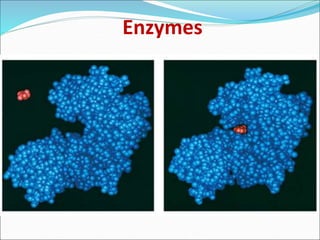
enzyme biochemistry classification regulation
- 1. Enzymes
- 3. What is an enzyme? globular protein which functions as a biological catalyst, speeding up reaction rate by lowering activation energy without being affected by the reaction it catalyse Active site
- 4. Enzymes are protein in nature (?) Globular protein. Ribozymes are RNA molecule with enzymatic activity. Catalytic behaviour of any enzyme depends upon its primary, secondary, tertiary or quaternary structure. Enzymes of digestive tract and those found in blood are present in inactive form called zymogen or proezymes.
- 5. Active site Enzymes are composed of long chains of amino acids that have folded into a very specific three-dimensional shape which contains an active site. An active site is a region on the surface of an enzyme to which substrates will bind and catalyses a chemical reaction.
- 6. Enzymes are highly specific for the type of the reaction they catalyze and for their substrate.
- 9. Mechanism of enzyme action The enzymatic reactions takes place by binding of the substrate with the active site of the enzyme molecule by several weak bonds. E + S ‹--------› ES --------› E + P Formation of ES complex is the first step in the enzyme catalyzed reaction then ES complex is subsequently converted to product and free enzyme.
- 10. "Lock and key" or Template model
- 12. e.g. H2O2 e.g. O2 + H2O Progress of Reaction
- 13. Nomenclature / enzyme classification IUBMB has recommended system of nomenclature for enzymes & according to them each enzyme is assigned with two names: Trivial name (common name, recommended name). Systemic name ( official name ).
- 14. Systemic name Each enzyme is characterized by a code no.called Enzyme Code no. or EC number and contain four Figure (digit) separated by a dot. e.g. EC m. n. o. p First digit represents the class; Second digit stands for subclass ; Third digit stands for the sub-sub class or subgroup; Fourth digit gives the serial number of the particular enzyme in the list. e.g. EC 2.7.1.1 for hexokinase.
- 15. Systemic name……… According to the IUBMB system of enzyme nomenclature enzymes are grouped into 6 major classes EC 1 OXIDOREDUCTASES EC 2 TRANSFERASES EC 3 HYDROLASES EC 4 LYASES EC 5 ISOMERASES EC 6 LIGASES
- 16. Factors affecting reaction velocity Temperature Hydrogen ion concentration (pH) Substrate concentration Enzyme concentration Products of the reaction Presence of activator/inhibitor Allosteric effects Time
- 19. Rate of the reaction or velocity is directly propostional to the Enzyme Concentration when sufficient substrate is present. Accumulation of Product in a reaction causes inhibition of enzyme activity.
- 20. Effect of Substrate Concentration Substrate Concentration/arbitrary Units Reaction Velocity (v0)
- 21. Enzyme Kinetics Study of reaction rate and how they changes in response to change in experimental parameter is known as kinetics. Amount of substrate present is one of the key factor affecting the rate of reaction catalyzed by an enzyme in vitro.
- 22. Effect of Substrate Concentration on Reaction Velocity
- 23. Michaelis- Menten Kinetics The model involves one substrate molecule, k1 k2 E + S ‹-------------› ES ------------ › E + P k-1 Where S is the substrate E is the enzyme K1, k-1 and k2 are the rate constants
- 24. The mathematical equation that defines the quantitative relationship between the rate of an enzyme reaction and the substrate concentration is the Michaelis-Menten equation: Vmax [S] V₀ = ------------- Km + [S] V₀ is the observed velocity at the given [S] Km is the Michaelis-Menten constant Km = (K-1 + K2) / K1 Vmax is the maximum velocity at saturating [S] conc.
- 25. Lineweaver-Burk (double reciprocal) plot A linear representation is more accurate and convinient for determining Vmax and Km. This equation is obtained by taking reciprocal of both the side of Michelis- Menton equation. 1/[S] vs. 1/Vo
- 27. Enzyme Inhibiton Any substance that can diminish the velocity of an enzyme catalyzed These include drugs, antibiotics, poisons, and anti-metabolites. Useful in understanding the sequence of enzyme catalyzed reactions, metabolic regulation, studying the mechanism of cell toxicity produced by toxicants. Forms the basis of drug designing.
- 28. Types of Enzyme Inhibiton Reversible inhibitors Irreversible inhibitors
- 29. Reversible inhibitors can be classified into : Competitive Non-competitive Un-competitive
- 32. Un-competitive Inhibiton Binds only to the enzyme-substrate complex. Does not have the capacity to bind to the free enzyme. Not overcome by increasing substrate concentration. Both the Km and Vmax are reduced.
- 33. Un-competitive Inhibiton Enzyme ES Complex + Inhibitor ESI complex
- 34. Km Enzyme Inhibition (Plots) I I I Competitive Non-competitive Uncompetitive Direct Plots Double Reciprocal Vmax Vmax Km Km’ [S], mM vo [S], mM vo I I Km [S], mM Vmax I Km’ Vmax’ Vmax’ Vmax unchanged Km increased Vmax decreased Km unchanged Both Vmax & Km decreased I 1/[S] 1/Km 1/vo 1/Vmax I Two parallel lines I Intersect at X axis 1/vo 1/Vmax 1/[S] 1/Km 1/[S] 1/Km 1/Vmax 1/vo Intersect at Y axis = Km’
Editor's Notes
- Type of specificity recognized : Absolute specificity, group specificity, reaction specificity and stereospecificity
- 這些 抑制機制都可以用酵素動力學來描述,使用雙倒數作圖更可明顯地指出是屬於何種抑制方式。不過,以上三種作圖都是屬於最典型者,很多時候實驗所得到的作圖結果,可能會有混合型態出現,則是較為複雜的抑制機制,或者有其他的干擾因子在內。